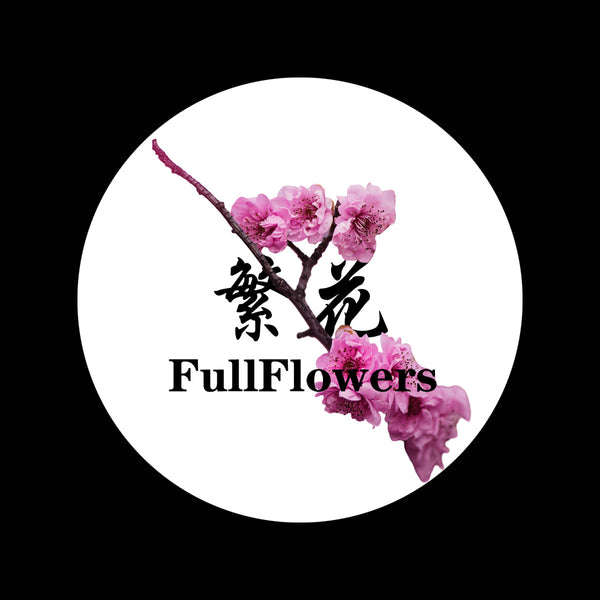
Classification of Ronghua(Velvet Flower) - Flat Velvet Style
Share
Ronghua(Velvet Flowers) are mainly divided into four major categories: velvet ball style, thick velvet strip style, thin velvet strip style, and flat velvet style. These four major categories are further divided into several subcategories.
Usually, artists will use multiple techniques according to their needs in a work, and will freely adjust according to the shape of the work. The techniques of these four major categories in the combing and twisting stages are similar, and detailed tutorials have been introduced in previous articles, so they will not be repeated here. The techniques after twisting are different for each category, so our later tutorials will be separated.
To make flat velvet style Ronghua(Velvet Flower), both Suzhou embroidery thread and Hunan embroidery thread can be used. However, the texture of the two types of threads may be slightly different.
The finished product of Suzhou embroidery thread has a better gloss and is more delicate, but the thread marks are heavier. The finished product of Hunan embroidery thread has richer colors, more uniform color transitions, and lighter thread marks. You can choose the silk thread according to your preference.
On the basis of modern technology,the flat velvet style Ronghua(Velvet Flower) incorporates hot flower technology, hand-painting technology, gold sprinkling technology, glitter technology, glue dropping technology, Raden Process, Wire Inlay Technology(掐丝工艺), Filigree Craft(花丝工艺), and burning edge technology.
Flat velvet style Ronghua(Velvet Flower) are usually used to make flowers and leaves. They have a rich and varied shape, a more modern sense, and are loved by young women.
Here are some examples:

The petals in the picture above use hot flower technology, and the leaves use gold sprinkling technology (the gold part is gold foil paper). Hot flower technology is usually used to make petals, etc.
The veins of the leaves in the picture above are hand-painted. To make hand-painted Ronghua(Velvet Flower), you need to have a certain foundation in painting. It is usually used to make butterflies, leaf veins, etc.
The dragonfly wings in the picture above use glitter technology
The butterfly wings in the picture above use glitter technology. The circle of metal wires inlaid around the butterfly uses Filigree Craft. Filigree Craft originates from an ancient technique - Filigree Inlaid Metal Art(花丝镶嵌). Filigree Inlaid Metal Art is to twist extremely thin metal wires into flower wires, and then weave or weld the flower wires into exquisite crafts.
Because of the high cost, Filigree Inlaid Metal Art is usually only enjoyed by royal nobles. It originated in China, and the specific time is no longer testable. The earliest Filigree Inlaid Metal Art cultural relics unearthed currently belong to the Spring and Autumn Period (700 BC to 400 BC,about 2400 to 2700 years ago).

The petals in the picture above use hot flower technology and glue dropping technology. Glue dropping technology is usually used in Ronghua(Velvet Flower) mainly for dewdrops on flowers and grass, which can make the work more vivid. Sometimes it is also used as a coating for Ronghua(Velvet Flower). The finished product can be more stable.
The petals in the picture above use hot flower technology, and the metal wires around the petals use Filigree Craft. The leaves use Wire Inlay Technology(掐丝工艺), glue dropping technology, and fine glitter technology.
The original color of the leaf is the green part exposed on the front. The yellow part of the leaf is coated with a layer of gold ink, and a layer of UV glue is covered on the gold ink. The metal wires around the leaves use Wire Inlay Technology.
Wire Inlay Technology originates from copper tire wire inlay enamel. Copper tire wire inlay enamel was introduced to China by Arab countries around the 13th century AD (the specific origin cannot be verified due to limited information here). During the Jingtai period of the Ming Dynasty in China(over 560 years ago), the technology developed rapidly, so it is also called Jingtai Blue(景泰蓝) in China.

The petals and leaves in the picture above use hot flower technology and Wire Inlay Technology.
The wheat ear in the picture above uses thick velvet strip technology, and the leaves use Filigree Craft, fine glitter technology, and hot flower technology.
The rose in the picture above uses hot flower technology and burning edge technology. Burning edge technology is usually used to make withered roses and leaves.

The wormhole in the picture above uses burning edge technology

The butterfly wings in the picture above use Filigree Craft and Raden Process. The pattern of the butterfly wings is a shell.
Raden Process usually refers to the decorative technology of grinding shells and sea shells into thin pieces of people, flowers and birds, geometric shapes or words, etc. And inlaying them on the surface of objects according to the needs of the picture.
Traditional Raden Process is usually combined with Chinese Lacquer Craft. Chinese Lacquer Craft refers to daily utensils, crafts, art, etc. made by applying natural raw lacquer on various objects.

Both Chinese Lacquer Craft and Raden Process are very ancient crafts, originated in China, and the specific years are not verifiable. The earliest Chinese Lacquer Craft and Raden Process artworks unearthed currently belong to the Shang Dynasty (1600 BC-1046 BC,about 3000 to 3600 years ago), and they are generally only used by royal nobles.



The butterfly pattern in the picture above is hand-painted (using pearlescent paint). To make hand-painted Ronghua(Velvet Flower), you need to have a certain foundation in painting. It is usually used to make butterflies, leaf veins, etc.

















